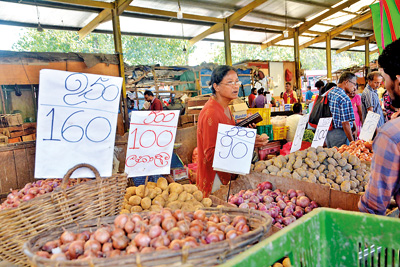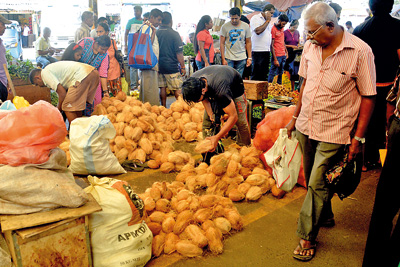News
Packet of trouble for lunch vendors as prices soar
I am hardly able to run my business these days,” says Slave Island rice packet seller Sudath Gunatilleke who, with other vendors, are squeezed into an impossible position between soaring rice and vegetable costs and inflexible sale prices. 
Many rice packet sellers, canteens and eatery owners are being forced to replace popular vegetables in their packets with cheaper ones such as sweet potato, pumpkin and dhal.
Mr. Gunatilleke, 40, who sells rice packets to mobile food carts and 50 small shops, said vendors like him just could not increase their prices when rice and vegetable prices rose.
His concerns are not uncommon. Other vendors and consumers are also worried about the rising prices.
Mr. Gunatilleke said the rice varieties that most people preferred were unavailable due to the shortage of rice. “Also, most of the favourite vegetables that people eat have increased due to adverse weather,” he said.
One vegetable seller, Raj Momamed, said prices normally increase at the end of a year and would return to normal in February and that the recent rains had sent prices higher than normal by damaging crops.

Pettah market: Consumers look despondently at the price of vegetables. Pix by Priyantha Wickramaarachchi
“It is very hard for us,” Mr. Gunatilleke said. “We cannot decrease the portion of rice or reduce the amount of vegetables that we include in our food. I only sell rice and curry and such a meal must have at least four varieties of vegetables,” he said.
He sells rice packets with chicken curry and vegetables for Rs. 200 each and packets with a vegetable, fish and egg for Rs. 150 and said if he raised those prices the shops would stop buying his produce.
“For Rs. 250 people will expect fried rice,” he said, when asked if he could increase the price of his packet of rice with chicken curry.
A cafe owner in Maradana that serves kottu roti and fried rice at Maradana, Mohammed Rishan, said he too had not increased prices even though the ingredients used for fried rice had increased.
He said a kilo of leeks was now Rs. 450 while a kilo of carrot is about Rs. 300 – both common ingredients in fried rice.
“I tried not to use onion leaves as they were Rs. 350 a kilo at the market on Wednesday so I bought leeks but found that was more expensive today. Since we cook in front of our customers everything we use has to be fresh, and we cannot reduce the quantity we serve,” Mr. Rishan said.
He said if he did not soon raise prices of the food he sold he would be unable to continue paying the wages of his five employees.
A manager of a restaurant in Maradana, S.M. Mustafa, complained that although the government claimed to have taken initiatives to reduce rice prices he could not find rice at the prices named by the government.
He and others had resorted to using keeri samba due to shortage of nadu and samba rice.
“The vegetable prices are high as the rains have damaged the crops so only a small amount of good-quality vegetables are available in the markets, and we are forced to spend more to buy them as demand is high,” he said.
Customers who patronise food outlets said their packets have become smaller, with cheap vegetables, but were being sold for the same price. Some even said vendors were reducing the number of vegetable curries in the packets.
People complained that most of the rich merchants at the markets only had the expensive varieties of rice such as keeri samba, rathu kekulu and sudu kekulu. 
This paper observed that several shops selling rice in hessian sacks had the prices displayed but did not name the varieties.
A retail shop keeper who requested anonymity said he could not sell nadu and samba for the government-stipulated price of Rs. 98 a kilo as he could not make adequate profits in buying for Rs. 96 and selling for only Rs. 2 more. He said some shops sell nadu and samba for Rs. 100-104. They only had small amounts for sale and he did not have any stocks, he said.
The shop keeper said some big mills were selling keeri samba for Rs. 165 a kilo when the price should be Rs. 140, and pointed out that his shop had been fined by the Consumer Affairs Authority for selling rice at high prices.
According to National Consumer Price Index, prices rose sharply last November for rice, vegetable, red onions, coconut, coconut oil, green chillies, chilli powder and milk powder.
A kilo of red kekulu rice was about Rs. 102 last month compared to Rs 81.64 in December 2018; white kekulu rice was Rs. 104 last month but Rs. 83.14 in the same month in 2018.
A kilo of red nadu, which was Rs. 96 in 2018, was retailing at Rs. 107 last month; white nadu had gone up from Rs. 87 to Rs. 106 in the same period. The exception was samba, which had been Rs. 111 a kilo in 2018 but had decreased slightly to Rs. 106 last month.
The government’s maximum retail price of Rs. 98 for nadu and samba is not reflected in average market prices, which are considerably higher.
Dried chillies were Rs. 500 a kilo last month, up almost Rs. 200 from a year before. Red onions rose from Rs. 195 in December 2018 to Rs. 480 last month.
Consumer Affairs Authority CEO M.S.M. Fauzer said only one rice variety, nadu, was in short supply and samba was available from limited stocks and that the current situation was a result of farmers not producing the rice varieties in demand.
“There are other varieties of rice in excess which are not in such high demand,” he said, adding that the government had taken a policy decision not to import rice as the Maha harvest would commence in about two weeks.”
Both nadu and samba are available at Sathosa shops at about Rs. 85.
“We raided 45,000 shops last year to see whether they are selling at government prices. We found about 4500 merchants selling nadu and samba with minor variations in price and we warned them, and we found another 862 merchants selling rice at high prices and took legal action against them,” Mr. Fauzer said.

Stocks of rice in Pettah: The government’s maximum retail price of Rs. 98 for nadu and samba is not reflected in average market prices, which are considerably higher





